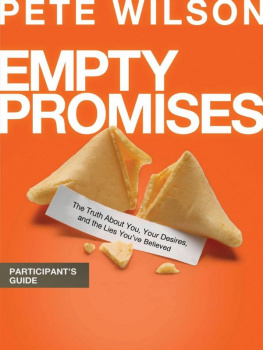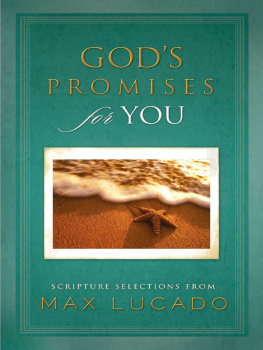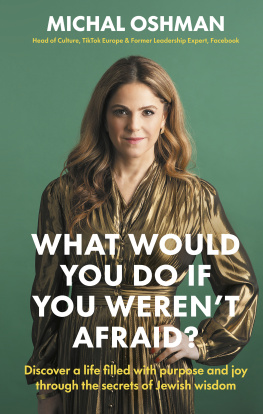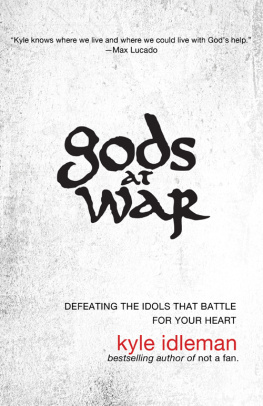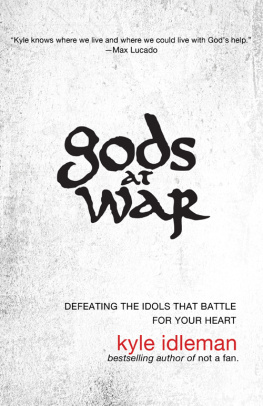Table of Contents
Landmarks
When I was a girl, my dad tried to talk me out of my Christian faith. I was nine when I heard about Jesus and his love for me. That was when my mom first took me to church, after she and my dad divorced. When I heard the gospel, by Gods grace and kindness alone I believed.
I dont blame my dad. When he heard about my plans to make a confession of faith and be baptized in the church, he felt I had been tricked, maybe brainwashed. Now that Im a parent, I can see how disconcerting it would be for a child of mine to pursue a worldview so in opposition to my own.
My dad was an attorney, and he asked good questions. I had no desire to follow a false faith, and I really wanted to please him. I wanted him to know that I had thought this through, that I wasnt being manipulated by anyone. And so as a teenager I was compelled to look into the veracity of the resurrection, how we got the canon of Scripture, and the historicity of both the Old and New Testaments. If you havent already, I encourage you to do the same.
Many of us never do this because we live in a culture that rewards distraction, consuming content for pleasure, and binge-watching much more than existential questions. Even when we had extra time on our hands during a global pandemic, how many Americans watched hours and hours of Tiger King on Netflix rather than read deeply to get to the bottom of why we believe what we believe? Even as hundreds of thousands died around the world, we numbed our minds rather than sharpened them.
Its easy to do, because were immersed in soundbites and syncretism. We oftenusually unknowinglyinvite a conglomeration of conflicting ideas into our hearts and minds. All at once we like to abide by the Golden Rule from Christianity, some Zen from the East, a little karma here, some penance there.
What concerns me about this way of life, though, is that our hodgepodge leaves us wanting.
Its chaos out here in the twenty-first century. We saw in the last chapter how quickly culture can change, how abruptly and absolutely societal convictions and values can be turned upside down. We need a timeless and true lens through which to view ever-changing trends.
Thats what this chapter is all aboutpreparing you and me, growing in us a reality-based understanding of ourselves and our world, so that we are ready for whatever comes. Not only will we be ready for the trials and tribulations that happen to us, but we will also be equipped to sift the chaos that swirls around us.
In this chapter were going to ask and answer some foundational questions that will build a bedrock for our faith so that we are able to stand, come what may. Well examine what God is like, what we are like, and what our world is like. This reality-based perspective will enable you and me to identify counterfeits whether they loom far out on the horizon or lurk right here inside us. Remember, human well-being requires harmony with reality. So lets ground ourselves in whats real.
Who Is God?
Our world had a personal beginning, not an impersonal, random one. Our Creator put forth thought and
And the world teems with evidence of that love, as well as our Creators personality, thoughtfulness, and delight: a glittery night sky, a bright red sunset, the shimmering scales on a lizards back, the enormity of a three-hundred-thousand-pound blue whale, the power of the Zambezi River as it plummets down Victoria Falls, a babys giggle, a new puppys breath, the melody of stringed and woodwind instruments playing in unison, sour lemons, and sweet blueberries.
God is love (1 John 4:8), says the apostle John, and so says the world around us.
God is relational. We can see this first in his own nature, as he is one God in three persons: Father, Son, and Holy Spirit. And we can see it secondly in how he relates to us. He did not make us because he was lonely but because he is good and loving. He does not stand far off. He is intimately involved in our own stories, as they flow out of his.
This is our God: good, kind, loving, personal, driven to relate to you and me. He has named every star (Ps. 147:4) and, at the same time, he knows just what you and I need before we even ask him (Matt. 6:8).
Who Are We?
You likely already know that God created Adam and Eve on the sixth day of his creating work. During the first five days he made light, the heavens and earth, the sea and the sky, a fertile earth with vegetation, the sun, moon, and stars, and the birds and fish. Then on the sixth day, God brought forth land animals and the first humans, Adam and Eve.
What you may not have considered, though, is how we were made to be cocreators and cocultivators with the Lord, and how we were made for community with one another. As discussed in chapter 2, Genesis 1 says God made man in his own image, imago dei (Gen. 1:27). We begin to understand what that means when God blesses Adam and Eve and tells them to be fruitful and multiply and fill the earth and subdue it and have dominion over the... earth (Gen. 1:28). Part of what it means to be made in Gods image is to be a cocreator and a cocultivator with him: to bring forth life and to care for it. We are to nurture what has been made, because behold, its all very good (Gen. 1:31).
Genesis 2 zooms in on the creation account and tells us three more instructive details about the creation of Adam and Eve. First, we see their creation couched in the generations of the heavens and the earth (Gen. 2:4). And twenty-five more times after that the Bible lists one version or another of our genealogythe generations of us, Gods people. Second, Moses tells us that the L ord God formed the man of dust from the ground and breathed into his nostrils the breath of life, and the man became a living creature (Gen. 2:7). And third, while Adam slept, God took out one of his ribs and with it made Eve (Gen. 2:2122). The creation of humans concludes with, Therefore a man shall leave his father and his mother and hold fast to his wife, and they shall become one flesh. And the man and his wife were both naked and were not ashamed (Gen. 2:2425 ).
The story of humans has always been communal and never individual.
We are a people who come from generations, who come from the dust of the earth and the breath of God. We are never self-made or isolated, and we never have been. We are couched in community, interdependent with others, and dependent on God.
Who we are has everything to do with whose we are. We belong to the Lord, our Maker, and we belong to one another.
What Are We Here For?
Have you ever looked deep into your morning coffee and wondered, What am I even doing here, anyway? I certainly have. And not just into my coffee. Into textbooks, babies diapers, moving boxes, social media, the bathroom mirror. Its a good question worth asking.
8:22) that what we see in the material world is not all there is. Our very nature points away from ourselves and cries out theres something more out there, something more to this life than what you see . Remember that quiet, second story in our heads that we discussed in chapter 1? This is why that story, that sense of more, persists from the backs of our minds. We were made to think this way.
While we all have the same purposeto glorify our Godwe are a diverse people with innumerable and unique contexts, callings, skills, and burdens. Our God is creative, and he made an immeasurable diversity of people to reflect him. The way you and I create and cultivate will not look the same, but we are each designed to bring order, beauty, and harmony to the place where God has us. That might be in your own home, on Wall Street, in politics, in overseas missions, in your cul-de-sac, or in your city.
Wherever you are, how can you see really see the people and places around you and bring the good, the beautiful, and the true image of God to bear on that setting? To do so is to bring God glory. It is to create his kingdom on earth, as it is in heaven. We were made for this.



